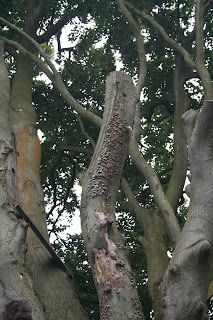Autumn is the time when many of the fungi, which have been living out of sight underground, or inside trees, produce their fruiting bodies. These can be toadstools or bracket fungi.
These fruiting bodies are called King Alfred's Cakes and grow mostly on dead ash wood. Inside they have concentric rings like tree rings which gives the species its scientific name of Daldinia concentrica.
In the grass by post number 1 found several examples of this big orange job. Our fungus expert, Simon, tells me it's probably a Boletus toadstool. Some of them can be poisonous so don't eat.
These two, probably Macrolepiota procera, growing near one of the large beech trees, were just flattening out into a toadstool shape when I came across them. What a piece of architecture!
The dead and fallen branches of the beech tree itself are decorated by another fungus, Bjerkandera adusta.
Just inside the main entrance in the grass, we have our annual crop of giant puffballs. These would grow to the size of small footballs if left to develop,
. . . . but unfortunately they often get kicked to bits and never reach their full glory.
One rather less welcome arrival in the grass was left by a large, probably canine, mammal, so watch where you are treading.
These can also appear in a longer-lasting form on trees and bushes. Look out!
We are grateful to all those who clear up after their dogs and those who take their litter home.

















































